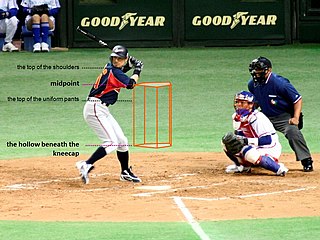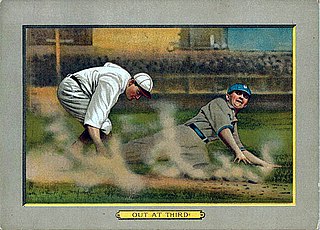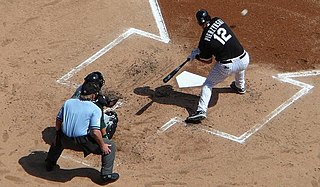
In baseball, an at bat (AB) or time at bat is a batter's turn batting against a pitcher. An at bat is different from a plate appearance. A batter is credited with a plate appearance regardless of what happens during their turn at bat, but a batter is credited with an at bat only if that plate appearance does not have one of the results enumerated below. While at bats are used to calculate certain statistics, including batting average and slugging percentage, a player can qualify for the season-ending rankings in these categories only if they accumulate 502 plate appearances during the season.

In baseball statistics, a player is credited with a plate appearance each time he completes a turn batting. Under Rule 5.04(c) of the Official Baseball Rules, a player completes a turn batting when he is put out or becomes a runner. This happens when he strikes out or is declared out before reaching first base; or when he reaches first base safely or is awarded first base ; or when he hits a fair ball which causes a preceding runner to be put out for the third out before he himself is put out or reaches first base safely. A very similar statistic, at bats, counts a subset of plate appearances that end under certain circumstances.

In baseball, the strike zone is the volume of space through which a pitch must pass in order to be called a strike even if the batter does not swing. The strike zone is defined as the volume of space above home plate and between the batter's knees and the midpoint of their torso. Whether a pitch passes through the zone is decided by an umpire, who is generally positioned behind the catcher.

Softball is a game similar to baseball played with a larger ball on a field that has base lengths of 60 feet, a pitcher's mound that ranges from 35 to 43 feet away from home plate, and a home run fence that is 220–300 feet away from home plate, depending on the type of softball being played. Softball is played competitively at club levels, the college level, and the professional level.

In baseball, an intentional base on balls, usually referred to as an intentional walk and denoted in baseball scorekeeping by IBB, is a walk issued to a batter by a pitcher with the intent of removing the batter's opportunity to swing at the pitched ball. A pitch that is intentionally thrown far outside the strike zone for this purpose is referred to as an intentional ball.

In baseball, an out occurs when the umpire rules a batter or baserunner out. When a batter or runner is out, they lose their ability to score a run and must return to the dugout until their next turn at bat. When three outs are recorded in a half-inning, the batting team's turn expires.

In baseball, the batting order or batting lineup is the sequence in which the members of the offense take their turns in batting against the pitcher. The batting order is the main component of a team's offensive strategy. In Major League Baseball, the batting order is set by the manager, who before the game begins must present the home plate umpire with two copies of his team's lineup card, a card on which a team's starting batting order is recorded. The home plate umpire keeps one copy of the lineup card of each team, and gives the second copy to the opposing manager. Once the home plate umpire gives the lineup cards to the opposing managers, the batting lineup is final and a manager can only make changes under the Official Baseball Rules governing substitutions. If a team bats out of order, it is a violation of baseball's rules and subject to penalty.

The rules of baseball differ slightly from league to league, but in general share the same basic game play.

In baseball, an appeal play occurs when a member of the defensive team calls the attention of an umpire to an infraction which he would otherwise ignore.

In baseball, batting is the act of facing the opposing pitcher and trying to produce offense for one's team. A batter or hitter is a person whose turn it is to face the pitcher. The three main goals of batters are to become a baserunner, to drive runners home or to advance runners along the bases for others to drive home, but the techniques and strategies they use to do so vary. Hitting uses a motion that is virtually unique to baseball and its fellow bat-and-ball sports, one that is rarely used in other sports. Hitting is unique because it involves rotating in the horizontal plane of movement, unlike most sports movements which occur in the vertical plane.

A box score is a chart used in baseball to present data about player achievement in a particular game. An abbreviated version of the box score, duplicated from the field scoreboard, is the line score. The Baseball Hall of Fame credits Henry Chadwick with the invention of the box score in 1858.

Pesäpallo is a fast-moving bat-and-ball sport that is often referred to as the national sport of Finland and has some presence in other countries including Germany, Sweden, Switzerland, Australia, and Canada's northern Ontario. The game is similar to brännboll, rounders, and lapta, as well as baseball.

A checked swing is a type of motion in baseball made by a batter. A checked swing occurs when a batter starts to swing the bat at the ball, but stops the swing in order to allow the ball to pass without hitting it. If the swing was indeed checked, so that there was no swing, and if the bat did not touch the ball and it did not go through the strike zone, the pitch counts as a ball; but in that circumstance if the swing was not checked, so that a swing occurred, then the pitch counts as a strike.












